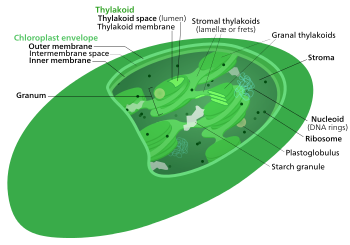The Calvin cycle, light-independent reactions, bio synthetic phase,dark reactions, or photosynthetic carbon reduction (PCR) cycle[1] of photosynthesis are the chemical reactions that convert carbon dioxide and other compounds into glucose. The Calvin cycle is present in all photosynthetic eukaryotes and also many photosynthetic bacteria. In plants, these reactions occur in the stroma, the fluid-filled area of a chloroplast outside the thylakoid membranes. These reactions take the products (ATP and NADPH) of light-dependent reactions and perform further chemical processes on them. The Calvin cycle uses the reducing powers ATP and NADPH from the light dependent reactions to produce sugars for the plant to use. These substrates are used in a series of reduction-oxidation reactions to produce sugars in a step-wise process. There is no direct reaction that converts CO
2 to a sugar because all of the energy would be lost to heat. There are three phases to the light-independent reactions, collectively called the Calvin cycle: carboxylation, reduction reactions, and ribulose 1,5-bisphosphate (RuBP) regeneration.
Though it is called the "dark reaction", the Calvin cycle does not actually occur in the dark or during night time. This is because the process requires reduced NADP which is short-lived and comes from the light-dependent reactions. In the dark, plants instead release sucrose into the phloem from their starch reserves to provide energy for the plant. The Calvin cycle thus happens when light is available independent of the kind of photosynthesis (C3 carbon fixation, C4 carbon fixation, and Crassulacean Acid Metabolism (CAM)); CAM plants store malic acid in their vacuoles every night and release it by day to make this process work.[2]
The sum of reactions in the Calvin cycle is the following:
- 3 CO
2 + 6 NADPH + 6 H+ + 9 ATP → glyceraldehyde-3-phosphate (G3P) + 6 NADP+ + 9 ADP + 3 H
2O + 8 Pi (Pi = inorganic phosphate)
Hexose (six-carbon) sugars are not a product of the Calvin cycle. Although many texts list a product of photosynthesis as C
6H
12O
6, this is mainly a convenience to counter the equation of respiration, where six-carbon sugars are oxidized in mitochondria. The carbohydrate products of the Calvin cycle are three-carbon sugar phosphate molecules, or "triose phosphates", namely, glyceraldehyde-3-phosphate (G3P).
The regeneration stage can be broken down into steps.
- Triose phosphate isomerase converts all of the G3P reversibly into dihydroxyacetone phosphate (DHAP), also a 3-carbon molecule.
- Aldolase and fructose-1,6-bisphosphatase convert a G3P and a DHAP into fructose 6-phosphate (6C). A phosphate ion is lost into solution.
- Then fixation of another CO
2 generates two more G3P. - F6P has two carbons removed by transketolase, giving erythrose-4-phosphate(E4P). The two carbons on transketolase are added to a G3P, giving the ketose xylulose-5-phosphate (Xu5P).
- E4P and a DHAP (formed from one of the G3P from the second CO
2 fixation) are converted into sedoheptulose-1,7-bisphosphate (7C) by aldolase enzyme. - Sedoheptulose-1,7-bisphosphatase (one of only three enzymes of the Calvin cycle that are unique to plants) cleaves sedoheptulose-1,7-bisphosphate into sedoheptulose-7-phosphate, releasing an inorganic phosphate ion into solution.
- Fixation of a third CO
2 generates two more G3P. The ketose S7P has two carbons removed by transketolase, giving ribose-5-phosphate (R5P), and the two carbons remaining on transketolase are transferred to one of the G3P, giving another Xu5P. This leaves one G3P as the product of fixation of 3 CO
2, with generation of three pentoses that can be converted to Ru5P. - R5P is converted into ribulose-5-phosphate (Ru5P, RuP) by phosphopentose isomerase. Xu5P is converted into RuP by phosphopentose epimerase.
- Finally, phosphoribulokinase (another plant-unique enzyme of the pathway) phosphorylates RuP into RuBP, ribulose-1,5-bisphosphate, completing the Calvin cycle. This requires the input of one ATP.
https://en.wikipedia.org/wiki/Calvin_cycle

No comments:
Post a Comment